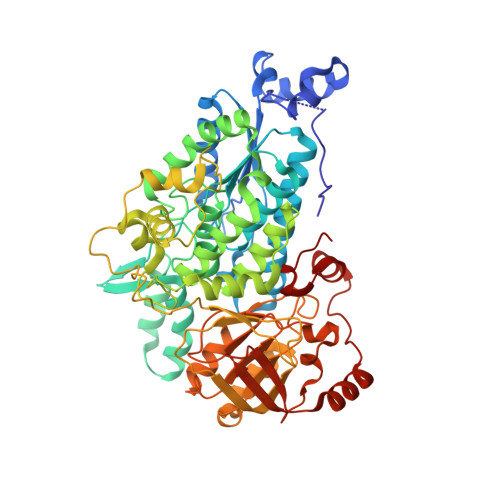Resistance-gene-directed discovery of a natural-product herbicide with a new mode of action.
Yan, Y., Liu, Q., Zang, X., Yuan, S., Bat-Erdene, U., Nguyen, C., Gan, J., Zhou, J., Jacobsen, S.E., Tang, Y.(2018) Nature 559: 415-418
- PubMed: 29995859
- DOI: https://doi.org/10.1038/s41586-018-0319-4
- Primary Citation of Related Structures:
5ZE4 - PubMed Abstract:
Bioactive natural products have evolved to inhibit specific cellular targets and have served as lead molecules for health and agricultural applications for the past century 1-3 . The post-genomics era has brought a renaissance in the discovery of natural products using synthetic-biology tools 4-6 . However, compared to traditional bioactivity-guided approaches, genome mining of natural products with specific and potent biological activities remains challenging 4 . Here we present the discovery and validation of a potent herbicide that targets a critical metabolic enzyme that is required for plant survival. Our approach is based on the co-clustering of a self-resistance gene in the natural-product biosynthesis gene cluster 7-9 , which provides insight into the potential biological activity of the encoded compound. We targeted dihydroxy-acid dehydratase in the branched-chain amino acid biosynthetic pathway in plants; the last step in this pathway is often targeted for herbicide development 10 . We show that the fungal sesquiterpenoid aspterric acid, which was discovered using the method described above, is a sub-micromolar inhibitor of dihydroxy-acid dehydratase that is effective as a herbicide in spray applications. The self-resistance gene astD was validated to be insensitive to aspterric acid and was deployed as a transgene in the establishment of plants that are resistant to aspterric acid. This herbicide-resistance gene combination complements the urgent ongoing efforts to overcome weed resistance 11 . Our discovery demonstrates the potential of using a resistance-gene-directed approach in the discovery of bioactive natural products.
Organizational Affiliation:
Department of Chemical and Biomolecular Engineering, University of California Los Angeles, Los Angeles, CA, USA.


















